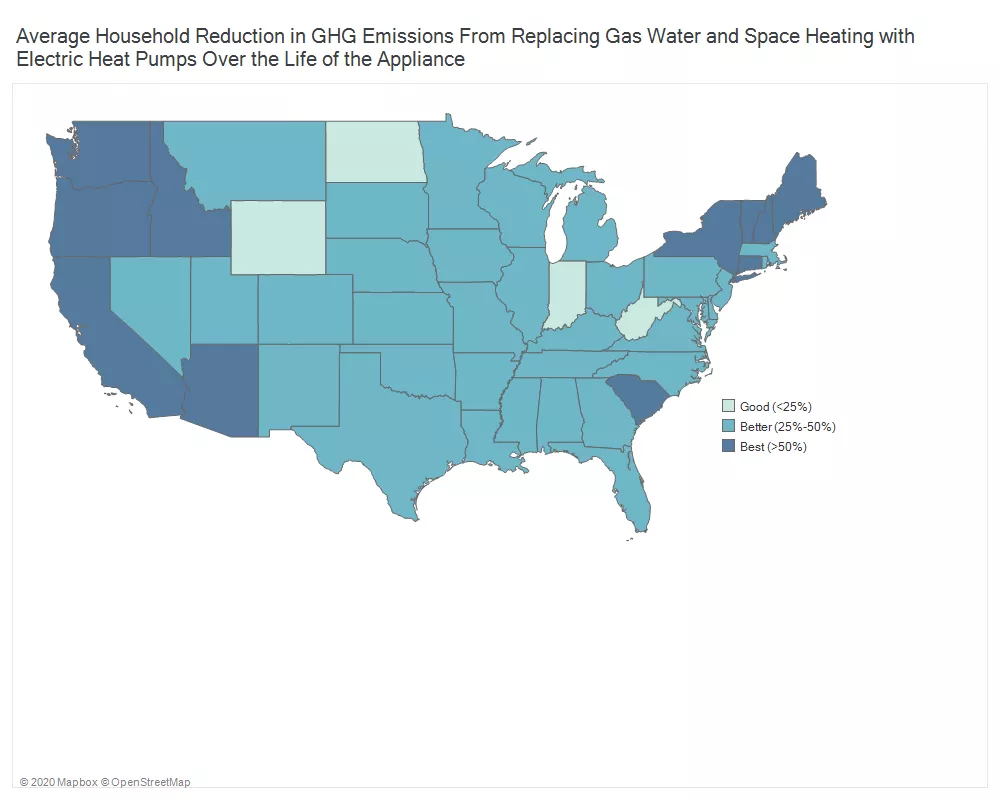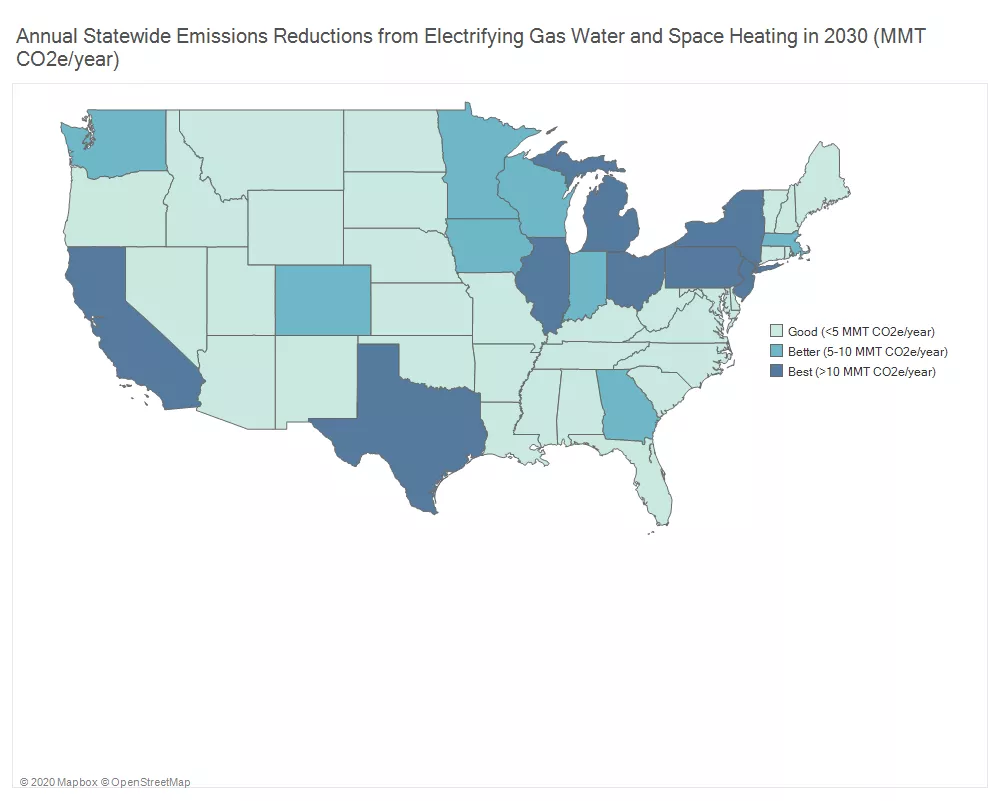Driven by communities’ desire for a stable climate and local clean energy, safer and healthier homes, and more affordable energy bills, we are seeing a movement for electric homes quickly spread across the US. More and more, people are becoming aware of the benefits of building electrification. Switching from gas to electric appliances is better for our health, improves the safety and resilience of our homes, and lowers energy bills. But with a greening grid that varies in resource mix by region and utility, how big are the climate benefits in each pocket of the country?
To answer this question, the Sierra Club conducted a detailed analysis of our current and future electricity grid and assessed the impact of converting homes heated by gas to electricity in every state. The answer is clear: Installing clean, electric heat pumps to replace gas water heaters or furnaces in every corner of the country cuts climate and health pollution. This is even true in states where coal and gas plants still power part of the electricity grid, and the climate benefits of electrification only improve as the grid continues to get cleaner over time.
The climate benefits of electrification are due to (1) the superior performance of heat pumps, which use at least three to four times less energy than gas appliances, and (2) the fact that electricity grids are already using significant amounts of renewable energy and will continue to get cleaner over the lifetime of a new electric appliance.
Electric heat pumps cut emissions in every state, especially when the grid is powered by clean energy.
Our analysis demonstrates that, while states with more ambitious clean energy deployment benefit the most, advanced electric appliances like heat pumps installed today will reduce greenhouse gas emissions in every state over the next 10 years of the appliance’s life.

In fact, for the average house, installing electric heat pumps in place of a gas furnace and gas water heater will reduce heating emissions more than 45 percent over the next 10 years. That’s the equivalent of cutting your gasoline car’s carbon pollution by more than half.
In the 12 states that are best positioned to use electric heat pumps to reduce emissions, households that switch to them will cut heating emissions by at least half over the next 10 years. In most of these states, that would keep as much carbon out of the atmosphere as giving up your car entirely.
Plus, as we accelerate the transition to clean and renewable energy and the grid gets greener, the climate benefits of going electric continue to improve. Let’s say that by 2030, we’ve retired all coal plants, and renewable energy makes up 40 percent of electricity generation -- not an unfeasible scenario. In that case, the average home in the US could reduce its emissions nearly 70 percent by swapping out a gas water heater and gas furnace with heat pumps.
Electrification yields major climate benefits across US by 2030.
Building electrification will reduce emissions in every state. It’s an essential strategy for states to achieve 2030 and longer-term climate targets.

In fact, 16 states could reduce emissions by over five million metric tons of CO2 equivalent (MMTCO2e) in 2030 by establishing policies that lead to residential electrification. California has the highest potential for emissions reductions from residential electrification, with potential annual savings of over 40 MMTCO2e in 2030. This is due to California’s already relatively clean grid (which is rapidly getting cleaner) and the large number (roughly 90 percent) of homes in the state that currently use gas appliances and could reduce emissions by switching to electric. New York similarly has high potential emissions reductions of nearly 30 MMTCO2e in 2030.
These climate benefits of electrification grow even more if policymakers focus not only on swapping out gas appliances for heat pumps (i.e., the focus of this analysis) but also on using heat pumps instead of water heaters and space-heating devices powered by fuel oil, propane, and electric resistance. This is particularly true in the Northeast and Southeast.
Decision-makers should adopt equitable electrification policies today.
As states consider how to support households during the COVID-19 crisis, energy regulators should consider how electrification can relieve families of high costs and damaging pollution while returning jobs to communities. Incentivizing electric heat pumps is just one way to achieve these goals.
In every state, electrification can help to reduce air pollution, improve public health and safety, lower energy bills, and cut greenhouse gas emissions. However, electrification will not happen at the speed, scale, or equitable manner required without strategic policy action and focused leadership today.
We’ve seen in recent history that clean energy policies can disproportionately benefit white and affluent communities. Decision-makers need to be vigilant to ensure that electrification measures are inclusive and explicitly designed to prioritize and protect people of color and low-income residents.
As policymakers look at opportunities to (1) put people back to work -- especially the energy efficiency workforce, which employs 2.3 million workers (28 percent of US energy workers) and has been especially hard-hit by the COVID-induced economic downturn, and (2) lower energy bills, we recommend a focus on stimulus measures that improve access to and build consumer demand for electrification.
State and local policymakers should adopt policies that:
Remove roadblocks and common barriers to electrification, particularly for low-income and environmental justice communities. More than two-thirds of low-income residents are renters facing a series of electrification challenges -- including housing that needs significant upgrades before electrifying; landlords motivated by cutting their capital costs, not the costs tenants bear or their quality of life; and a housing affordability crisis where housing supply is drastically insufficient.
Lower bills for residents (especially low-income residents) who electrify with incentives, rate reform, and inclusive financing. This also includes protecting tenants from rent hikes or eviction if landlords use public incentive dollars to electrify properties.
Ensure that families in affordable housing or with low or fixed incomes are first in line for the benefits of electrification. Develop and fund comprehensive programs to fix health and safety problems, improve efficiency, and electrify homes at essentially no cost for families in affordable housing, or with low- or fixed-incomes.
Establish the goal of a zero-emission buildings sector by no later than 2045, through interim enforceable targets. This will send a much needed signal and certainty to utilities, unions, building trade professionals, and third-party energy service providers, enabling them to plan for and benefit from a clean energy, zero-emissions future.
Strengthen standards for buildings and appliances to require zero emissions. Adopting performance or emission standards for buildings and appliances is a key way to regulate a sector that has too often defaulted to voluntary decisions by building owners and developers. Emissions-based regulations, especially for appliances, can provide certainty on the timeline to ratchet down air and climate pollution levels to achieve safe air and climate goals.
Educate and inspire consumers and the workforce. As explained in The Greenlining Institute’s report “Equitable Building Electrification: A Framework For Powering Resilient Communities,” this must be done in culturally appropriate ways, with attention to language and community needs, and by partnering with and empowering community-based organizations.
More guidance on electrification policies is available in our “Building Electrification Action Plan for Climate Leaders.”
About This Analysis
This analysis is relatively conservative by design so as not to overstate the potential emission reductions from residential electrification. Our bottom-up analysis compares the relative emissions of the most-efficient gas water heaters and furnaces with efficient electric heat pumps, adjusting the efficiency of the heat pumps by the climate.
To calculate the carbon intensity of today’s electric supply, we use the marginal electricity generation (i.e., the new electric supply that will get used to power a heat pump) from the EPA’s AVoided Emissions and geneRation Tool (AVERT) 2018 data. We then project the carbon intensity of the grid in 2030, making the assumptions that there is no coal online and that renewables make up roughly 40 percent of electricity generation.
We factor in methane leakage to both gas power plants (2.9 percent) and to the gas appliances (3.2 percent). This is based on our analysis of the methane leakage literature, which finds fugitive emission rates ranging from 1.4 percent to 7.9 percent. The increased leakage rate for gas combusted inside homes is supported by the growing research showing that at least 0.5 percent of the gas that passes through residential meters leaks. Given the short life of methane in the atmosphere and the urgency of addressing these emissions, we use a 20-year time horizon with methane having a global warming potential of 86 times the warming potential of carbon.
We do not assume any residential efficiency improvements, installation of rooftop solar or energy storage, or opting into a green tariff program. We also do not assume the heat pumps are programmed to be used when the grid is lower-carbon, which is an increasingly common practice, especially for heat pump water heaters that can provide thermal energy storage. Emissions savings would be even higher if we assumed some or all of these changes. This analysis also did not factor in the health and safety benefits of replacing gas appliances with electric alternatives.
Our findings are consistent with a recent report in Nature Sustainability showing that under current carbon intensities of electricity generation, heat pumps reduce emissions compared with fossil-fuel appliances in 53 of 59 world regions, representing 96 percent of global heating demand.
